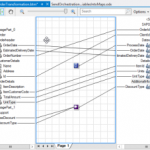This post was originally published here
August 15, 2016
One of the many challenges with an integration project is typically the mapping of messages from one API to another. The difficulty most often lies not with the technical implementation (although some former projects mapping SAP iDocs to EDI X12 are still giving me nightmares), but rather with forming the specification of the mapping itself, including understanding the semantical meaning behind each element. This is difficult because it requires expert knowledge of both the source and target system, as well as an analysts who can correct “draw the connecting line” between the two. The correct end result is only achieved through significant collaboration amongst the relevant parties.
The BizTalk Mapper goes a long way to facilitating this task with it’s graphical mapping interface. Aside from providing the developer a means of rapidly implementing a transformation, it also servers as a visual representation of the mapping that can be understood by a business analyst (if not too complex):
(image courtesy of MSDN)
There are two problems with this approach, however:
- It requires BizTalk Server, which is not only expensive, but also may be overkill for a solution that can easily be implemented in WCF, REST, or another platform;
- The mapping must be implemented by a developer before it can be shown to analysts and business users for discussion and validation. This usually entails a number of iterative cycles until the mapping is correct.
Enter api-map.com – a new free online tool created by my colleague Joseph Cooney specifically to address these particular challenges. api-map provides a medium to formulate, display and share mapping documentation which can eventually be handed over to a developer for implementation on any chosen platform.
As a first step, the tool allows you to upload schemas (either JSON or XML) with the ability to display, edit and annotate them:
These schemas can then be used to define mappings, even providing automatic hints along the way using very clever heuristics. You can specify direct mappings or indicate that a transformation is required – including a description of the necessary condition and/or logic that defines the transformation. You can also map multiple source elements to a single target, and specify constant values to be assigned where appropriate.
Once this is completed, you can then display the mapping in a clear visual diagram that is easily understood by any analyst. Even better, you can combine multiple diagrams into one composite “end-to-end” view – providing a traceability which you cannot achieve within BizTalk maps. This is incredibly useful in the situation where canonical business schemas are employed within an ESB (a common scenario for most of my projects). And by selecting any element involved in a mapping, you get an independent end-to-end view of all elements involved in a mapping:
Finally, when everything has been sorted, you can export the mapping to a handy Excel spreadsheet, serving as documentation within a source repository for developers to work from:
A few other nifty features include the ability to tag items to make them searchable, join teams in order to share project artefacts, and an option to attach images of a user interface to clarify the association of an element with a system control.
Watch Joseph’s video to see a live demonstration of the tool. Still in beta, Joseph is continually adding new features, but already I believe this will be a handy utility on many of my upcoming projects!
